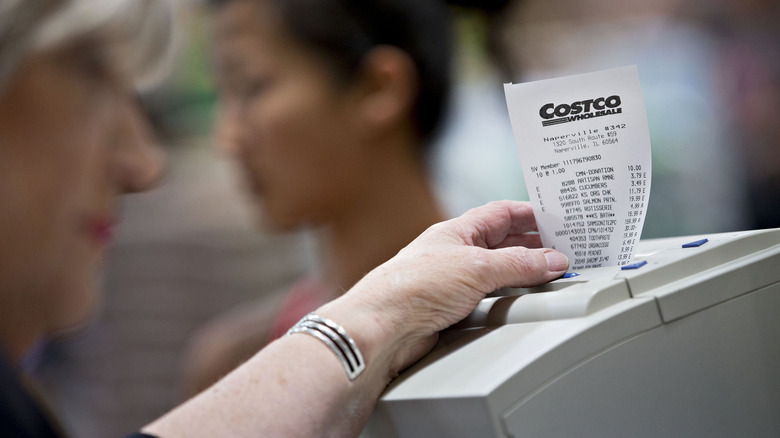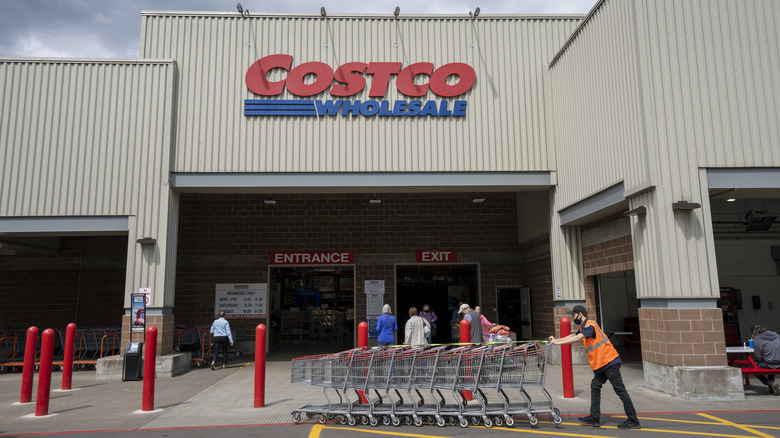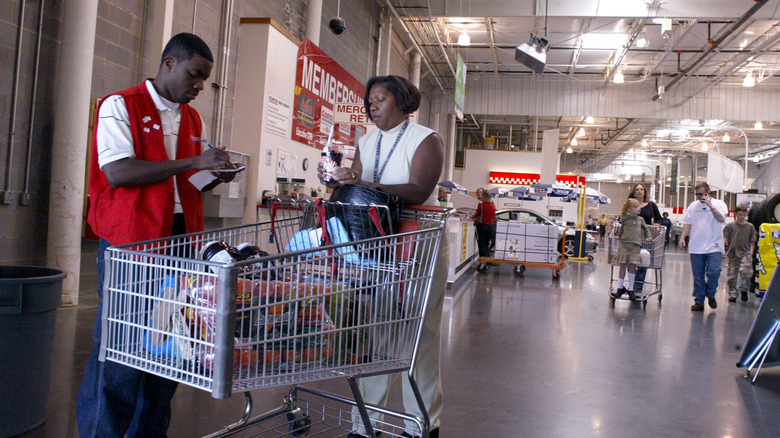What Costco Workers Are Looking For When They Check Your Receipt
The experience of shopping at a Costco is unlike those at most other stores. When you first walk into the warehouse, an enormous cart in tow, you'll have to flash your membership card at an employee. By proving that you are a paying and rule-abiding member of the exclusive retailer, you're granted access to rows upon rows of products as far as the eye can see. Assuming that you've made it through the maze of floor-to-ceiling pallets and massive freezers to pay for your items, there's one more stop between you and the parking lot. As you meander toward the warehouse's exit, an enormous and now full cart in tow, another employee will be waiting for you at the door. This time, instead of your card, they'll want to check your receipt.
It's not unheard of for retailers to have a worker inspecting receipts as shoppers exit a store. Often, this practice is to prevent theft. And while it might feel like a hassle or a slight to your integrity, at Costco, the process can benefit you. In fact, there are several reasons exit greeters scan for errors or discrepancies that don't involve shoplifting. As they check to make sure what's on the receipt matches up with what's in your cart, Costco employees are searching for a few key pieces of information. Here's the lowdown on what they're looking for.
Confirming you got what you paid for
Costco has been checking receipts since its first warehouse opened in 1983. And despite what some members might think, the workers doing so aren't out to get you. Instead, the Costco employees stationed at the exit are often looking for things that your cashier may have missed, according to the company's website. After all, mistakes happen. By keeping an eye out for them, the retailer can accurately track its inventory and save you from losing money.
Impressively efficient at counting the contents of your cart, exit greeters compare the total number of items listed at the bottom of the receipt to how many you're walking out with. This certainly does help with loss prevention, and in an annual report, the company even pointed to these practices as helpful in keeping its inventory loss low. However, this practice also ensures you're being charged correctly for what you're leaving with. For example, many of Costco's bakery treats, such as the danishes and bagels, are sold in quantities of two. If you've only grabbed one, the receipt checker will flag it and send you to grab your rightful second. Additionally, if you've been mistakenly charged twice for the same item, a quick scan of your receipt can guarantee that the error is caught and fixed.
Initials, codes, and other receipt secrets
What you buy at Costco can affect what receipt checkers are looking for, too. According to Costco employees interviewed by Business Insider in 2019, certain merchandise like jewelry, stamps, and electronics require a supervisor's initials. This is also the case for any item over $300. Similarly, large merchandise like toilet paper or cases of bottled water are marked by special signifiers, too. As a worker scans your receipt and notices this, they'll be reminded to check for bulky items at the bottom of the cart's basket.
There are also indicators to make sure receipts aren't reused. Workers check for a special code at the top and bottom of your receipt. Written as a letter followed by a number, say J6, it changes daily to indicate when the receipt was printed. This is an easy way to confirm that your purchase and receipt were made on the day you show them at the door. You may have also noticed that before the exit greeter hands your receipt back, they draw a line on it. This prevents it from being used as your ticket out of the store on another Costco trip.
While you might be in a hurry to escape the warehouse's chaos, having your receipt checked by a Costco employee is just another part of being a member of this exclusive store. It may not feel as important as stopping for free samples, but this brief pause before you head home ensures that you're leaving with everything you paid for.


